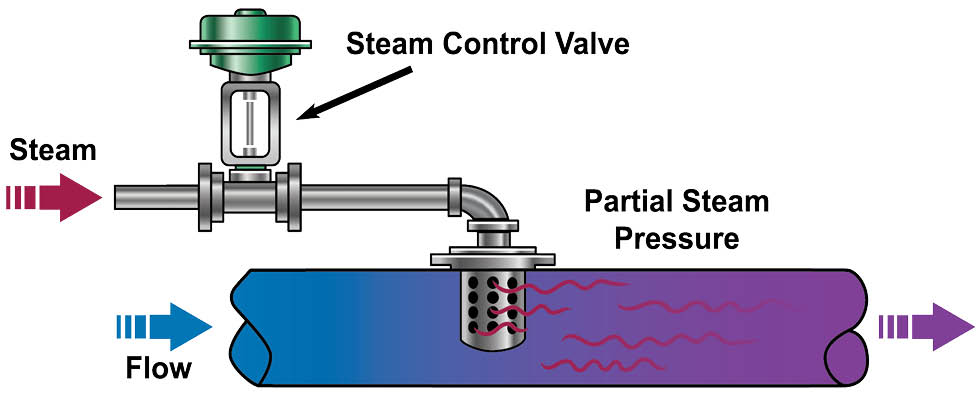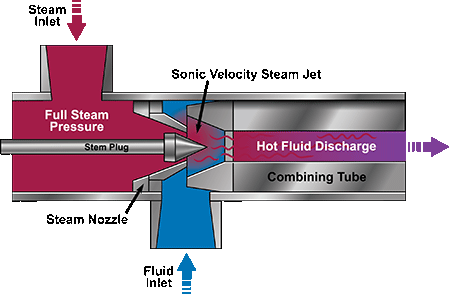
Ensuring cleanliness and hygiene is important regardless of industry. Proper sanitation practices are not only vital for user safety, but also essential for daily operations. A highly effective sanitization method involves using steam to heat water in hose stations.
These stations offer a straightforward and efficient approach to eliminating pathogens while minimizing the risk of cross-contamination. However, it is crucial to recognize the limitations and potential hazards associated with certain traditional hose station heating systems and to explore the advantages of utilizing internally modulated direct steam injection (DSI) technology. DSI heating solutions provide precise temperature control and enhanced operator safety, improving sanitization processes overall.
Understanding Hose Stations & Their Role in Sanitization
A hose station is a versatile piece of equipment that combines steam and water in controlled proportions to produce a high-temperature, steam-heated water solution. This solution is used in various areas, including equipment cleaning, surface sanitization and sterilization.
For example, hose stations are commonly used to clean and sanitize equipment, surfaces and utensils in washdown applications. The high temperature of the steam-heated water solution effectively eliminates pathogens and other microorganisms that can threaten the cleanliness and safety of the production environment.
Pathogen elimination
The high temperature of the water in sanitization processes aims to eliminate various harmful microorganisms, including pathogens, viruses and fungi. These may include common bacteria such as Escherichia coli (E. coli), Salmonella, Listeria monocytogenes, Staphylococcus aureus and Campylobacter that may be present on equipment, surfaces or utensils.
Controlled, high-temperature water is a powerful sanitizing agent, destroying many microorganisms and ensuring a hygienic environment. Pathogens typically thrive between 40 and 140 F but begin to die off at temperatures ranging from 140 to 180 F and above. By utilizing steam to heat the water, the risk of introducing external contaminants into the water is eliminated, helping preserve the effectiveness of the sanitization process while preventing the spread of harmful microorganisms.
Versatility and Flexibility
Hose stations are versatile in their use. They can be used for various cleaning and sanitization tasks, including equipment cleaning, surface sanitization and sterilization. The steam-heated water solution can be adjusted to different temperatures, making it suitable for various cleaning requirements.
Regulation compliance
Some facilities must adhere to strict sanitation regulations to ensure the safety and quality of their products. These hose stations provide a reliable method for achieving the required levels of cleanliness and sterility. They help facilities meet regulatory standards and maintain a hygienic environment, reducing the risk of foodborne illnesses while ensuring user satisfaction.

Disadvantages of Externally Modulated (DSI) Hose Stations
Hose stations that use externally modulated direct steam heating systems rely on a steam control valve on the supply line to adjust steam pressure at the injection point, affecting steam density and velocity through the nozzle for heating control. These systems also typically include globe valves to manually control steam and water flow.
The mixing valve combines water and steam to produce a steam-heated water solution for equipment cleaning, surface sanitization and sterilization. These systems are often favored for their cost-effectiveness, simplicity and ease of use, as they have a straightforward design and only a few components to maintain.
However, these mixing valves have drawbacks. They do not respond well to flow changes, requiring frequent adjustments to the liquid and steam inlet valves to achieve desired temperatures. Fluctuations in steam pressure can also disrupt the process, producing unstable operating conditions, hammering and vibration when high or low steam flow rates are required. This can lead to wasted time when adding or removing hoses, as the mixing valve needs readjustment.
Additionally, mixing valves have faced criticism due to safety concerns related to steam burns. The manual opening and closing of globe valves during operation poses a risk of accidental contact with high-temperature steam, which can lead to severe burns. These accidents can result in injuries, downtime and increased costs. Therefore, organizations with the safety of their employees in mind have actively sought alternatives to mixing valves that prioritize operator safety and minimize the risk of steam burns.
Internally modulated DSI technology provides an alternative to inlet valves, addressing the limitations and safety concerns associated with externally modulated systems.

Advantages of Internally Modulated (DSI) Hose Stations
Unlike externally modulated systems, internally modulated direct steam injection heating operates at higher steam velocities, facilitating improved and rapid mixing and instantaneous steam condensation into the process fluid. DSI technology is used across various industries, injecting steam directly into liquids or fluids to heat them.
The working principle of internally modulated DSI technology involves generating steam in a separate boiler and injecting it directly into the liquid or fluid that requires heating. As the steam enters the liquid, it rapidly condenses, transferring heat energy and raising the temperature.
By adopting internally modulated DSI heaters in hose stations, facilities can enhance their sanitization practices, optimize efficiency, comply with regulations and prioritize operator safety. These heaters provide precise temperature control, effectively handling higher swings in flow rate and offering higher flow turndown, ensuring optimal sanitization without overheating. Giving facilities tighter control over their water temperature enables them to meet regulatory requirements and more easily minimize contamination risk.
Internally modulated DSI systems also offer safety features that make them more attractive than traditional hose stations. Steam is generated downstream and piped directly into the hose station, eliminating operator exposure to hot temperatures when using the system. This prevents potential scalding or burn injuries, enhancing overall safety.
Facilities that have adopted internally modulated DSI technology have experienced notable improvements in
their sanitization practices, efficiency, regulatory compliance and workplace safety. By prioritizing the safety and well-being of their operators, these facilities have created a work environment that is both safer and cleaner.
Hose stations play a pivotal role in sanitizing equipment and surfaces by utilizing steam to heat water, eliminating bacteria, preventing cross-contamination and helping facilities adhere to regulatory standards. However, traditional hose stations have faced criticism due to safety concerns. More and more facilities are using internally modulated DSI technology to address these concerns, as they offer precise temperature control and enhanced operator safety.


